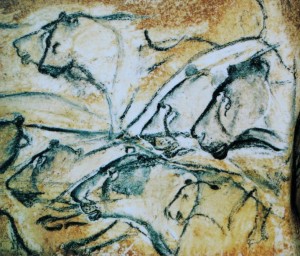Lions and Tigers and Cave Bears! Oh My!
In 1994, three cavers out on a hike in Southern France happened to feel a faint draft from a hillside and decided to investigate. Behind it was a cave where no human had set foot for tens of thousands of years. The cavern was rich with sparkling stalactites, bones of ancient fauna and charcoal sketches dating back 32,000 years that rocked the worlds of art, history and paleontology. These astounding paintings are the subject of Werner Herzog’s new documentary, Cave of Forgotten Dreams.
The movie, filmed in glorious 3D, tells the story of these cave paintings. While 3D has up till now been almost exclusively reserved for action and fantasy movies, Herzog uses the format to enhance the documentary. 3D can sometimes seem like a gimmick or an afterthought; here it is crucial to telling the story of Chauvet Cave. The artists who created the cave paintings made excellent use of the relief of the cave walls, and the extra dimension makes a significant difference in appreciating their work.
Tucked away from the world behind a 20,000-year-old rockslide, the cave has an astonishingly finicky atmosphere and climate. Only a few people may enter at one time, they must use cool lights, and they must stay on a metal walkway that at times only spans one foot across. Scientists restricted the filmmaking so much, in such limited space that the crew appears in many shots, crawling through spaces that would give a claustrophobic a conniption fit. If one of them were to lose their balance, even for a moment, their handprint on the wall could ruin a masterpiece. Because neither the public nor anyone else, but a handful of elite scientists will ever be allowed inside the cave, Herzog acts as the cave’s ambassador to the world.
The movie has a haunting, poetic quality to it. As the camera pans around the cave, a choir sings, and few will remain unmoved by the wispy images revealed by unsteady flashlight, meant to evoke the flicker of a fire. Through sketchy layers that look almost like stills from early animation, animals depicted in the paintings give the illusion of snorting, running, and snarling.
The Europe, in which the anonymous artists lived, looked and felt vastly different than the continent we know today. Glaciers covered much of France, and many of the animals such as woolly mammoths, wooly rhinoceros and even cave bears are now extinct. One reason to be grateful to the anonymous artists is that scientists now have a clear picture of these prehistoric animals. For instance, before the discovery of the paintings in Chauvet Cave, paleontologists did not know whether the European cave lion had a mane or not. The paintings show that unlike the African lion of the modern era, the male cave lion did not have a mane.
In 1940, Pablo Picasso toured Lascaux cave, also in the south of France. After seeing the paintings on the wall he remarked, “We have discovered nothing.” Herzog, too, seems to think that art has not significantly improved in the past 30,000 years.
Herzog’s direction and narration of the film makes it a unique documentary. In a scene near the end, he remarks on the footprint of an eight-year-old boy next to the footprint of a wolf found deep within the cave. He speculates as to whether the wolf might have attacked the boy, “or did they walk together as friends?” he asks. Or, maybe, he goes on, the two prints were thousands of years apart. This bit of narration reveals much about Herzog’s style. While he always tells the truth, the way he sets up the story allows us to imagine the infinite possibilities the truth may—or may not—suggest.
Herzog’s fame as a documentarian gives him a lot of leeway when it comes to a surprising twist in the narrative at the very end of the story. No spoilers will be revealed here, but let’s just say things take a sharp turn toward the weird.
Cave of Forgotten Dreams teaches the viewer something about life for early humans, now-extinct animals, and the French ministry of culture, but in some ways, it brings up more questions than it answers. Who were the people who braved the stony cold centuries of the ice age? How did they speak? What did they wear? What were their moral values? In the end, we are left only to dream ourselves.


